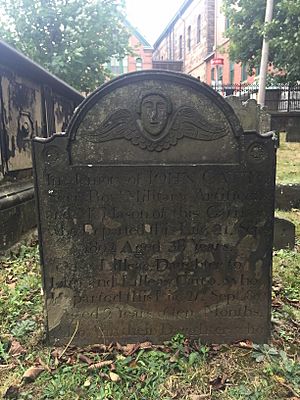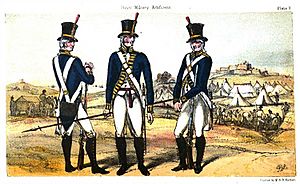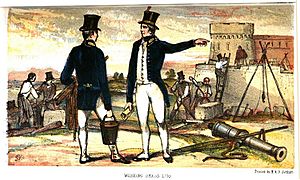Soldier Artificer Company facts for kids
The Soldier Artificer Company was a special group of soldiers in the British Army. They were formed in Gibraltar in 1772. Their main job was to build and improve the strong walls and defenses of Gibraltar. Before this company, the army used regular workers, but they were not always reliable. This new company was the first time the army had its own skilled workers, called artificers. An artificer is someone who is skilled in a craft, like building or repairing things.
The company was very successful right away. They helped make Gibraltar's defenses much stronger before a big attack called the Great Siege of Gibraltar. During the siege, which lasted from 1779 to 1783, the Soldier Artificers were super important. They fixed damage from enemy attacks and even dug tunnels inside the Rock of Gibraltar. These tunnels allowed the defenders to fire cannons down at the Spanish attackers. After the siege, they helped rebuild the town in Gibraltar. The company grew bigger over time, reaching about 250 men. Their success led to similar groups being formed in Britain, which eventually became today's Royal Engineers. The Soldier Artificer Company joined with these new groups in 1797.
Contents
History of the Soldier Artificers
How the Company Started
The Soldier Artificer Company was created by Lieutenant Colonel William Green. He wanted to make the fortifications of Gibraltar much better. Green was the main engineer in Gibraltar starting in 1761. In 1769, he suggested big plans to improve the defenses. The British government finally approved these plans in October 1770.
At first, civilian workers from England and other parts of Europe did the building. But these workers were not soldiers, so they didn't have to follow military rules. It was hard to manage them. If they misbehaved, the only choices were to tell them off, stop their pay, or fire them. Firing them caused delays and cost more money to find new workers. These problems made the building work slow and expensive.
To fix this, Green suggested creating a company of military artificers. Soldiers in the garrison had sometimes used their building skills before. Green's idea was liked by the Governor of Gibraltar and sent to a high-ranking government official for approval. On March 6, 1772, the King agreed. A document was issued to create a 68-man company. It included sergeants, corporals, a drummer, and 60 private soldiers. These privates were skilled workers like stonecutters, masons, miners, carpenters, and blacksmiths. Officers from the existing Corps of Engineers, who were all high-ranking officers, led this new company. It was quickly renamed the Soldier Artificer Company.
Many civilian workers were let go when the company started. A few skilled ones were kept, but none joined the new company. It was easy to find enough men, as soldiers from the Gibraltar garrison volunteered. The company quickly proved to be much better than the civilian workers. On March 25, 1774, the company was allowed to grow to 93 members. This included more sergeants, corporals, and 23 more private artificers. General Robert Boyd, a leader in Gibraltar, praised the company's work. He wrote that they were the only ones who could be depended on for steady work. He said that without them, the King's Bastion and other forts would not have been built as quickly.
The King's Bastion was a very important project for the company. It was a key fort right on the waterfront. Building started in 1773, but it was slow at first. Some foreign workers left, and fewer soldiers were available to help. So, the company was expanded again on January 16, 1776, to 116 men. The company worked on the bastion from morning till night, even on Sundays. They finished it in 1776. The bastion had over 20 cannons and strong, bomb-proof rooms that could hold 800 men. It proved how important it was during the Great Siege of Gibraltar, which started in June 1779.
The Great Siege of Gibraltar
The Soldier Artificers played a huge part in defending Gibraltar during the siege by Spanish and French armies. They were split into three groups to help make the forts stronger when the fighting began. At the peak of the siege in 1782–83, almost 2,000 soldiers worked on the forts. The Soldier Artificers guided all this work.
On November 27, 1781, the artificers took part in a very successful British attack. They helped destroy the Spanish trenches and disable their cannons. The Governor, General George Eliott, praised them. He said they worked incredibly fast. In just half an hour, two mortar batteries and three gun batteries were on fire and ruined. Their cannons were spiked, and their equipment was destroyed. Their ammunition stores exploded one after another. The artificers also helped the gunners by providing "red-hot shot." This meant heating cannonballs in special ovens until they were glowing red. These hot cannonballs caused huge fires when they hit enemy ships or buildings.
Even with British attacks, the Spanish slowly moved closer to Gibraltar. They extended their trenches towards the British lines. The closer they got, the harder it was for the British to aim their cannons down at them. The steep cliff on the North Front of the Rock of Gibraltar limited where British cannons could be placed. By May 1782, the Spanish had knocked out many British batteries on the North Front. The British couldn't fire back well enough.
General Eliott offered a reward of 1,000 Spanish dollars (a type of money) to anyone who could find a way to fire on the enemy's works from the side. The company's Sergeant-Major, Henry Ince, had an idea. He suggested digging a tunnel through the Rock to a spot called the Notch. A cannon could be placed there to cover the whole North Front. His idea was approved right away. The Soldier Artificers started digging on May 25, 1782. As they dug, the tunnellers decided to make an opening in the cliff for fresh air. They quickly realized this opening would be a perfect place to fire a cannon. By the end of the siege, this new tunnel, called the Upper Gallery (now known as the Great Siege Tunnels), had four cannons. These cannons were on special "depressing carriages" that allowed them to fire downwards at the Spanish. The Notch itself was reached only after the siege ended. Instead of putting a gun above it, they hollowed it out to create a wide firing position.
Besides digging tunnels, the company was busy repairing damage from Spanish attacks on the fortress. Their biggest loss of life during the siege happened on June 11, 1782. A Spanish shell hit the ammunition storage at Princess Anne's Battery. This caused a huge explosion. The storage was completely destroyed, and debris flew down the slope, causing many injuries and deaths. Fourteen soldiers died, and 15 more were wounded. By July, the company had lost 22 men. Six were killed by the enemy, and the rest died from illnesses. More men were urgently requested from England. On August 31, 1782, the company was allowed to grow even more. It would have one sergeant-major, 10 sergeants, 10 corporals, 209 private soldiers, and four drummers. The 141 new recruits arrived in Gibraltar in October.
The company also had two boys, Thomas Richmond and John Brand. Their older comrades called them "Shell and Shot." They were sons of company sergeants and were trained as a carpenter and a mason. They worked in the forts, watching for enemy shells and warning others. Their sharp eyesight saved many lives, making them famous in the garrison. After the siege, both boys received a good education. They later became second lieutenants. They were sent to the West Indies but sadly died there from yellow fever in 1793.
Rebuilding and Joining Forces
By the end of the siege in February 1783, seven men from the company had been killed. Another 23 had died from sickness. Two men were also punished for breaking rules in May 1781. However, unlike other British groups, no one from the company ran away during the siege. The company's amazing tunnel work led to even more digging. By 1790, over 4,000 feet (about 1,200 meters) of tunnels had been dug. Sergeant-Major Ince remained in charge of this work.
The Soldier Artificers also helped rebuild the town of Gibraltar, which was in ruins. They repaired and strengthened the forts even more. New men joined the company from other regiments in Gibraltar. These artificers had special privileges. They didn't have to do guard duty, and other soldiers did their cleaning and cooking.
In June 1786, the Soldier Artificer Company was reorganized. It was split into two companies because it had grown so much. Many members, 86 of them, were discharged. This was over a third of the company. Some had discipline problems, but the main reason was that many were too old and weak for the hard work. Since experienced craftsmen were needed, the average age of the men was higher than in regular army units. Recruits were often between 35 and 45 years old, and sometimes even 50. The older members were replaced with younger men, aged 35 or under, mostly masons and bricklayers. The total number of Soldier Artificers increased again. However, a group of new recruits (58 men, 28 wives, and 12 children) had a terrible journey. On September 24, 1786, their ship, the Mercury, was wrecked off Dunkirk. Only three men were rescued from the water, and two of them died soon after.
The next year, a high-ranking official named the Duke of Richmond suggested creating six companies of 100 soldier artificers in Britain. He wanted them to be like the Soldier Artificer Company in Gibraltar. Richmond wanted to build and fix many forts, just like Green had done in Gibraltar years before. He was also unhappy with hiring civilian workers. Some people argued that it was silly to put workers under military rules, but the King and Prime Minister approved the idea. In October 1787, a document was issued to create the Royal Military Artificers and Labourers. The Soldier Artificers in Gibraltar were asked if they wanted to change their red uniforms to the new blue uniforms of their British counterparts. They agreed, and from 1788, all soldier artificers in the British Army wore the same uniforms.

In June 1797, the Soldier Artificers joined with the Corps of Royal Military Artificers. This group was a very early version of today's Royal Engineers. By this time, the Soldier Artificers had two companies. Each company was supposed to have two sergeant-majors, five sergeants, five corporals, two drummers, and 125 private artificers. However, the actual numbers were a bit lower when they joined. Their discipline had gotten worse during peacetime, and there were often problems with drinking and misconduct. Even so, their work remained high quality as long as their officers and non-commissioned officers watched them closely. When they joined, the total number of men in the corps reached about 1,075.
A statue on Gibraltar's Main Street remembers the Soldier Artificer Company. It says: "Presented to the people of Gibraltar by the Corps of Royal Engineers to commemorate the continuous service given by the corps on the Rock of Gibraltar from 1704, and the formation here in 1772 of the first Body of Soldiers of the Corps, then known as the Company of Soldier Artificers. (26 March 1994)." In 1972, the Gibraltar Philatelic Bureau (which makes stamps) issued a stamp celebrating the Soldier Artificers and 200 years of the Royal Engineers in Gibraltar.







